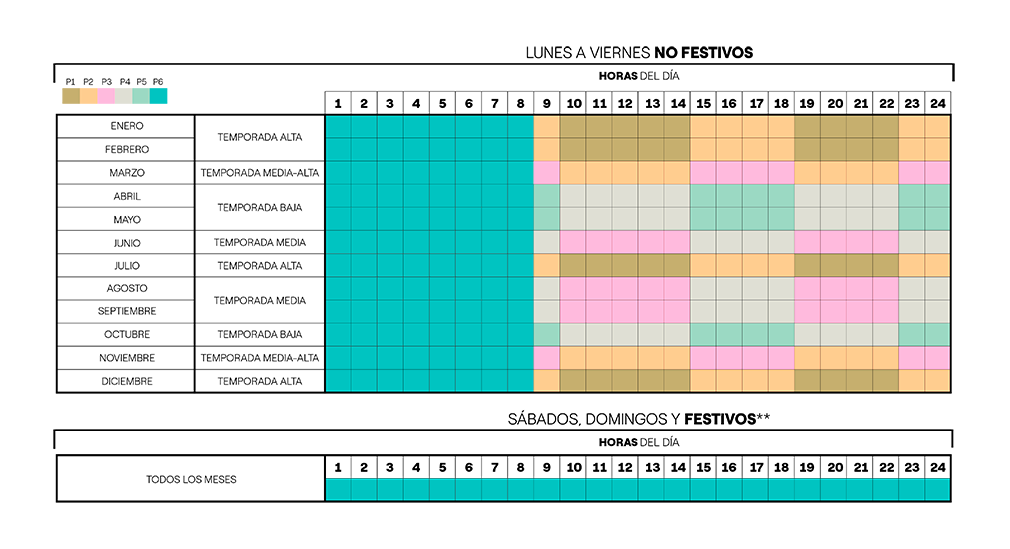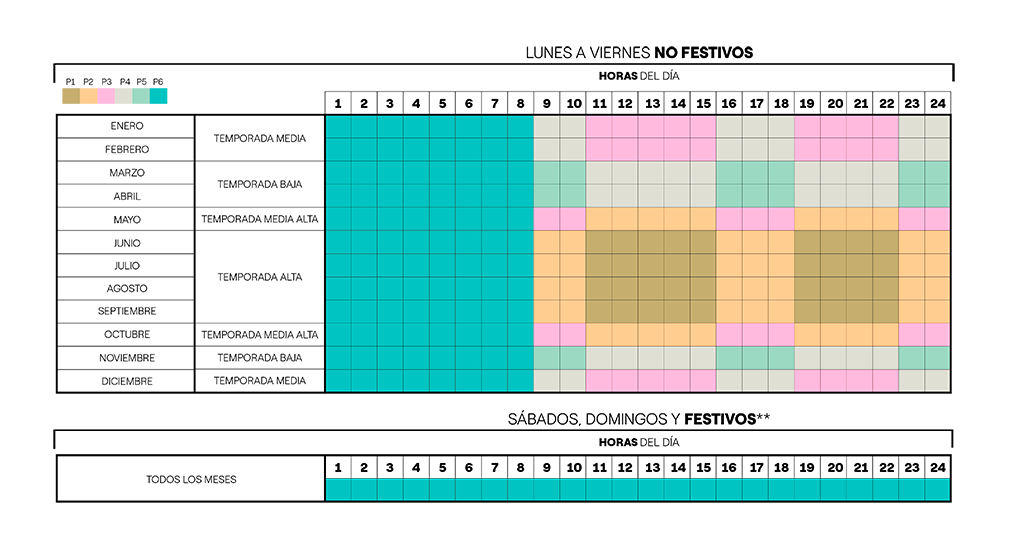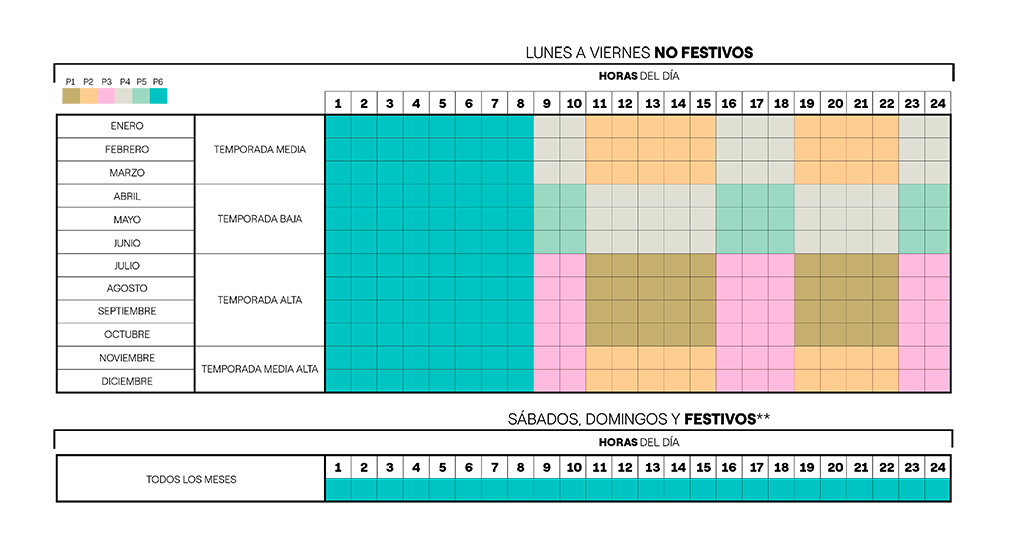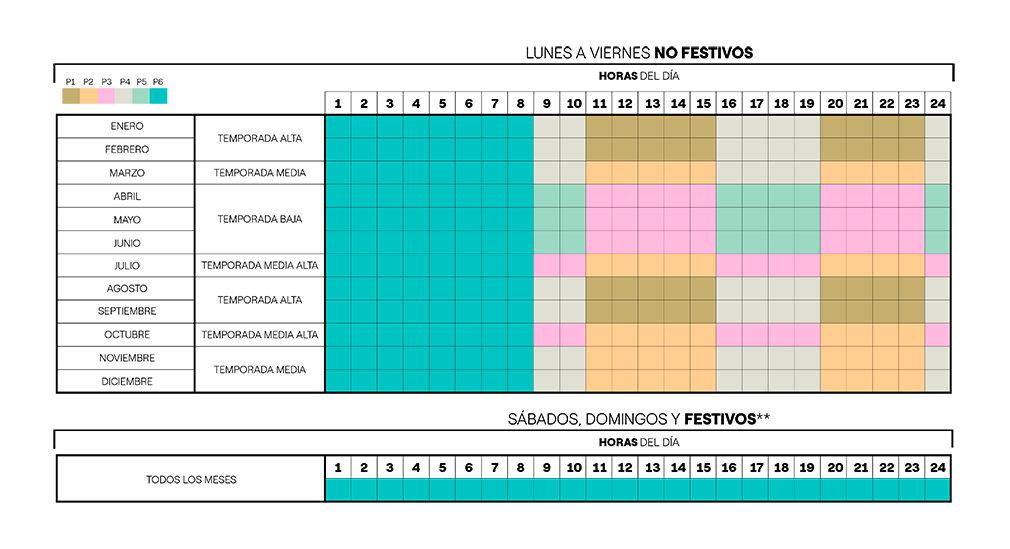Nuevos peajes y cargos de la luz 2021
Las tarifas de acceso 3.0A para hogares o empresas con potencia contratada superior a 15 kW y en baja tensión (tensión inferior a1 kV) pasan a tener el peaje 3.0TD con 6 periodos en los términos de potencia y energía. Los cargos del sistema que le corresponden se denominan “segmento de cargos 2” y tienen la misma estructura que los nuevos peajes.
Esta nueva estructura de peajes y cargos trae consigo cambios en tres aspectos:
- Se amplían a 6 los periodos de discriminación horaria, tanto en potencia como en energía.
- Los periodos horarios (de P1 a P6) se diferencian en función de la zona geográfica, temporada, día de la semana y hora del día. El periodo valle (P6) se amplía al incluir todas las horas de los sábados, domingos y festivos.
- Las potencias contratadas tienen que seguir el criterio de orden creciente, es decir, la potencia contratada en el periodo P1 debe ser menor o igual a la del P2, la del P2 menor o igual a la del P3, y así sucesivamente hasta el periodo P6.
Cambios en el término de energía de los peajes y cargos de la luz en 2021
Se establecen 6 periodos para los peajes y cargos que se dividen según la temporada, el día de la semana y la hora del día, con el siguiente calendario según el territorio en que vivas:
Península
(**) Festivos nacionales excluidos tanto los sustituibles como los que no tienen fecha fija, y 6 de enero.
Baleares
(**) Festivos nacionales excluidos tanto los sustituibles como los que no tienen fecha fija, y 6 de enero.
Canarias
(**) Festivos nacionales excluidos tanto los sustituibles como los que no tienen fecha fija, y 6 de enero.
Ceuta
(**) Festivos nacionales excluidos tanto los sustituibles como los que no tienen fecha fija, y 6 de enero.
Melilla
(**) Festivos nacionales excluidos tanto los sustituibles como los que no tienen fecha fija, y 6 de enero.
Cambios en el término de potencia de los peajes y cargos de la luz en 2021
El término de potencia pasa a tener 6 potencias contratadas con precios distintos, una para cada uno de los 6 periodos horarios del término de energía.
Las potencias contratadas tienen que seguir el criterio de orden creciente, es decir, la potencia contratada en el periodo P1 debe ser menor o igual a la del P2, la del P2 menor o igual a la del P3, y así sucesivamente hasta el periodo P6.
A partir del 1 de junio de 2021, por defecto se adaptan las potencias contratadas a los seis periodos según lo establecido en la normativa:
- Potencia contratada en el periodo P1: Potencia contratada anteriormente en el periodo P1.
- Potencia contratada en los periodos P2, P3, P4 y P5: Potencia contratada anteriormente en el periodo P2 (si no cumple el criterio de potencias crecientes, potencia contratada en el periodo P1).
- Potencia contratada en el periodo P6: Potencia contratada anteriormente en el periodo P3 (si no cumple el criterio de potencias crecientes, potencia contratada en el periodo P5).
A partir del 1 de junio de 2021 y dentro de los 12 meses siguientes, tendrás la oportunidad de modificar tus potencias contratadas de manera gratuita y hasta dos veces para adaptarlas a los nuevos periodos horarios, siempre que la nueva potencia contratada sea igual o inferior a la máxima de las potencias contratadas en el momento del cambio. De lo contrario, deberás abonar el coste de los derechos de acometida según la normativa en vigor.
¿Cómo se facturan los excesos de potencia en los nuevos peajes?
La nueva normativa también introduce cambios en la facturación de la potencia demandada que aplican al peaje 3.0TD.
Si la potencia demandada sobrepasa en cualquier periodo horario la potencia contratada en el mismo, se aplicarán los recargos por los excesos registrados en cada periodo, de acuerdo con lo siguiente:
- Para los puntos de medida tipo 4 y 5 con excesos, se seguirá facturando mediante maxímetro, estableciéndose el doble del Término de Exceso de Potencia, para el excedente de la potencia demandada.
- Para el resto de los puntos de medida, tipo 1, 2 y 3, se mantiene el procedimiento de facturación mediante curva de carga cuartohoraria, donde el Término de Exceso de Potencia que sea de aplicación tendrá un recargo para desincentivar la contratación de potencias inferiores a las demandadas.
En caso de que se demande menos potencia de la contratada ya no aplicarán las bonificaciones que hubieran podido corresponder.
¿Cómo se facturan los excesos de energía reactiva en los nuevos peajes?
El término de facturación por energía reactiva inductiva se mantiene en el peaje 3.0TD, expresado en €/kVArh. Se aplicará sobre todos los periodos horarios, excepto en el P6, siempre que el consumo de reactiva inductiva exceda el 33% del consumo de activa.




